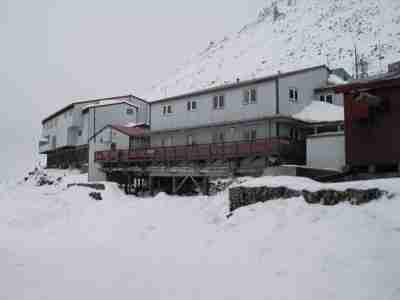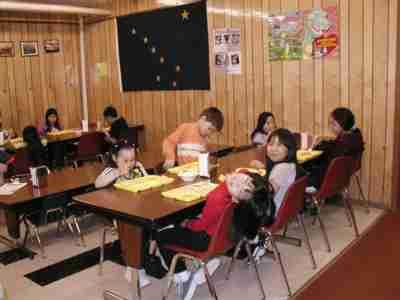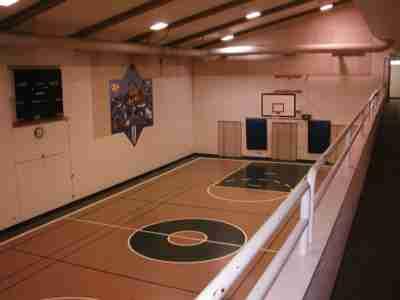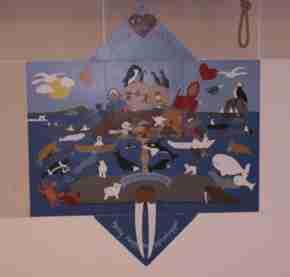
|
|
3 March, 2002

This is the school, where Dr. Jolles and I are staying. There are no hotels or guest accommodations in the village, and since our research here has a strong educational component, we have been invited to sleep in the school. The school is actually quite a luxurious place to stay as it has the only running water and flush toilets on the island other that in the Health Clinic. The original school house, built in the first half of the 1900s burned down. This school building was originally constructed as two separate buildings; an elementary school which has the cafeteria and library, and the high school and gymnasium/auditorium. These two separate structures were later joined together by a long connecting hallway, giving students access to each building without having to go outside into the arctic weather conditions each time. The school is well equipped with computers in every room, and other than the small class sizes, the classrooms do not look much different from classrooms in any other school setting. The community here on Little Diomede is made up of between 150-160 people, approximately half of whom are children under the age of 18 years old. Here on Diomede, as in all communities in the United States, children under the age of 16 years old are required to attend school. Currently the school has approximately 42 students in grades Kinder. through twelfth grade as well as a Head Start program for three and four year olds. Classes are small, sometimes as small as three to six students, and are often a multiage or combination of grades. The school is staffed by six teachers, some of whom have come to teach from other parts of Alaska, others from "the lower 48." There is also one Principal and at least four adult teacher's aides from the community. This is a wide view of the school taken from the ice. The school sits, quite literally at the edge of the island, where land meets sea. The stone wall that is evident at the base of the school is actually a breakwater and the ice in the picture is not land, it is the frozen Bering Sea. During the months when the sea is not frozen, it's not uncommon for spray from the sea to coat the windows with salt, making them appear to be opaque.

This is the school cafeteria where children are served both breakfast and lunch. Carol and I have been fortunate to be able to share meals with the children, making food preparation and mealtimes much more enjoyable. (Remember, there are no restaurants on the island.) In contrast with schools in Los Angeles, inclement weather is a common occurrence here and all school facilities are indoors. The children were delighted when I showed them pictures of the outside lunch area where my students in Los Angeles eat under trees and shade canopies. This is one of many opportunities to build on the similarities between our two very different communities as well as to learn from the differences in our daily experiences and ways of life.

Here I am with the two women who run the cafeteria: Isabelle Iyapana is on the far right and Dora Ahkinga (pictured in the middle) who is also the current mayor of Injaliq

The island of Little Diomede is believed to be a dormant volcanic plug. It is very steep, rising to a height of 1300 feet. The island is rocky and steep and affords no large flat areas, except during the winter months when the sea freezes over and the ice expands the island's area for a number of square miles to the north, south and between the two Diomedes. For that reason, this school gymnasium is the largest, flat play area. During the school day the younger students have their PE and recess breaks here and the older students use the gym to play basketball. During the school year, this gym also serves as a community meeting place where whole families can come for recreation as well as the occasional movie screening.

A close up of the mural in the gymnasium. Students worked with an artist to design this mural, showing elements of traditional hunting and gathering activities and highlighting the marine mammals and birds that are such an essential part of this ecology and the subsistence way of life.

This is the school library, and the place that Carol and I will be calling home for the next month. We must be up and out of the way each morning before school begins, but are very warm and comfortable in this setting. And although we are guests in the school, we are not the only residents; one of the elementary teachers makes her home in the classroom in which she teaches. She has a kitchen area, and we share the bathroom and toilet facilities.
Contact the TEA in the field at
.
If you cannot connect through your browser, copy the
TEA's e-mail address in the "To:" line of
your favorite e-mail package.
|
